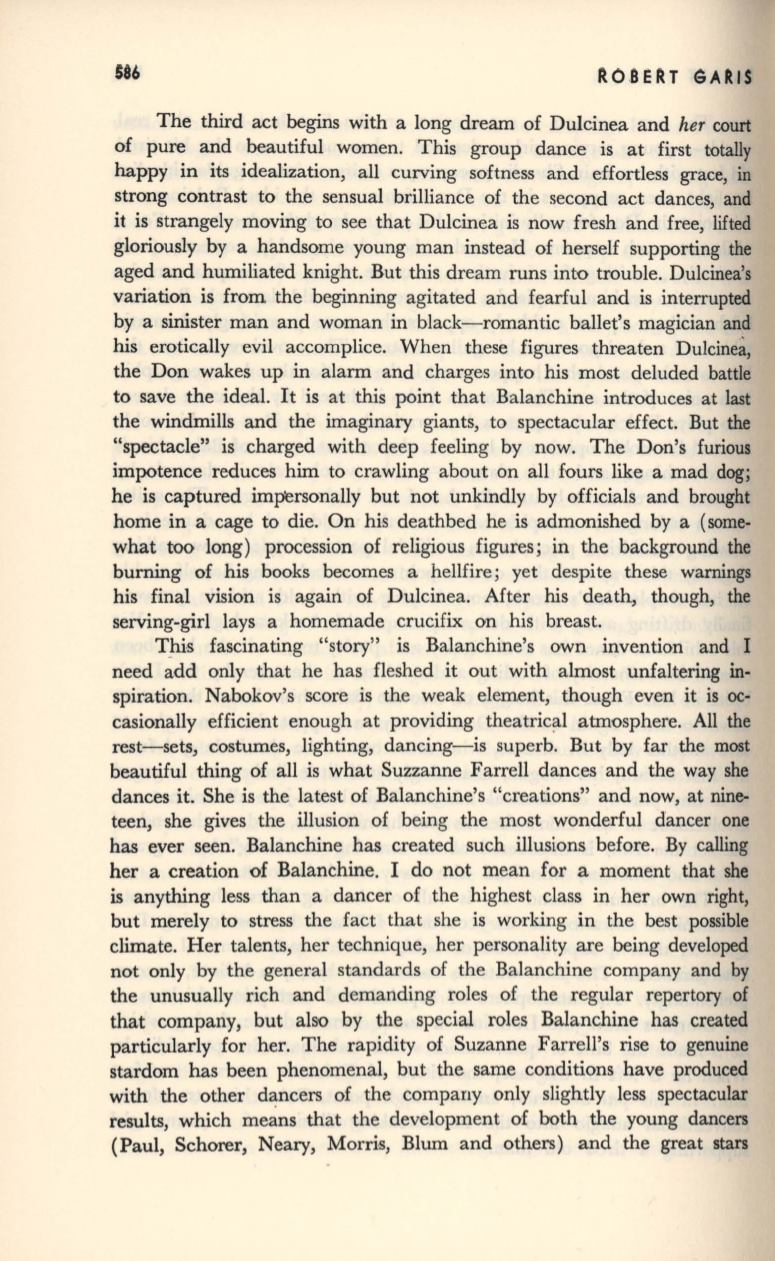
S46
ROBERT
~ARIS
The third act begins with a long dream of Dulcinea and
her
court
of pure and beautiful women. This group dance is at first totally
happy in its idealization, all curving softness and effortless grace, in
strong contrast to the sensual brilliance of the second act dances, and
it is strangely moving to see that Dulcinea is now fresh and free, lifted
gloriously by a handsome young man instead of herself supporting the
aged and humiliated knight. But this dream runs into trouble. Dulcinea's
variation is from the beginning agitated and fearful and is interrupted
by a sinister man and woman in black-romantic ballet's magician and
his erotically evil accomplice. When these figures threaten Dulcinea,
the Don wakes up in alarm and charges into his most deluded battle
to save the ideal. It is at this point that Balanchine introduces at last
the windmills and the imaginary giants, to spectacular effect. But the
"spectacle" is charged with deep feeling by now. The Don's furious
impotence reduces him to crawling about on all fours like a mad dog;
he is captured impersonally but not unkindly by officials and brought
home in a cage to die. On his deathbed he is admonished by a (some–
what
too
long) procession of religious figures; in the background
the
burning of his books becomes a hellfire; yet despite these warnings
his final vision is again of Dulcinea. After his death, though, the
serving-girl lays a homemade crucifix on his breast.
T_his fascinating "story" is Balanchine's own invention and I
need add only that he has fleshed it out with almost unfaltering in–
spiration. Nabokov's score is the weak element, though even it is
oc–
casionally efficient enough at providing
theatric~l
atmosphere. All the
rest-sets, costumes, lighting, dancing-is superb. But by far the most
beautiful thing of all is what Suzzanne Farrell dances and the way she
dances it. She is the latest of Balanchine's "creations" and now, at nine–
teen, she gives the illusion of being the most wonderful dancer one
has ever seen. Balanchine has created such illusions before. By calling
her a creation of Balanchine. I do not mean for a moment that she
is anything less than a dancer of the highest class in her own right,
but merely to stress the fact that she is working in the best possible
climate. Her talents, her technique, her personality are being developed
not only by the general standards of the Balanchine company and by
the unusually rich and demanding roles of the regular repertory of
that company, but also by the special roles Balanchine has created
particularly for her. The rapidity of Suzanne Farrell's rise to genuine
stardom has been phenomenal, but the same conditions have produced
with the other dancers of the company only slightly less spectacular
results, which
me~ns
that the development of both the young dancers
(Paul, Schorer, Neary, Morris, Blum and others) and the great stars


